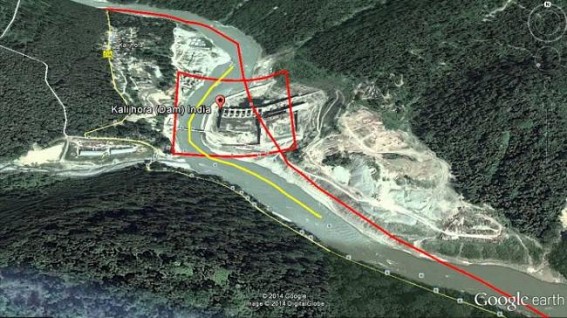Shilajit Kar Bhowmik

PHOTO : Teesta river Indo-Bangla Satellite Map by Google
Recent bloodshed and barbaric unlash on humanity in neighbouring Bangladesh hit the heart of common Tripurites badly. Not me, but many of my grand-pa and grand-ma have memorable history of past in undivided East Pakistan. Thousands of minority commoners of Bangladesh in those days had to shift this side leaving behind high valued immovable property.
Of course, the more precious gift of the ancestors had been left uncared and finally, occupied by others. The landlords of East Pakistan became rootless migrants in Tripura in those days. When memory recalls the days, many death-bed ridden elderly persons still can’t control the tears of agony. But when we the younger generation see the atrocity on humanity in Bangladesh now – can easily anticipate the misery of our forefathers in those days.
We are not strangers to the prolonged amity between India and Bangladesh since the birth of the latter on 16 December 1971. Inasmuch irrigated or watered by rivers, Bangladesh naturally thrives on agricultural activities and fisheries. This cites its dire need of water, the main origin of which is India – be it in the form of Padma or Yamuna. Prior to transcendence of Indian borders, the rivers relish the name of Ganga, Brahmaputra, and Gomati and so on. Barring border fencing, India and Bangladesh are two sides of the same soil, air and water. Some Indian places also have linguistic uniformities with Bangladesh. West Bengal, Tripura and Silchar are the best example Indo-Bangla uniformity.
Homogeneities in language, culture and food cement the bonding between the two countries. Bangladesh henceforth always seeks India’s consent on sharing of water to sustain its agriculture, the main source of the country’s economy. The amicable relations between India and Bangladesh embarked on a new chapter with the signing of the Ganga water-sharing agreement by former Prime Minister of India H D Deve Gowda and present Bangladesh Prime Minster Sheikh Hasina on December 12, 1996. This agreement was limited to 30 years.
It’s in the backdrop of Indo-Bangladesh friendship treaty signed on March 19, 1972. This was considered to be a key to the setting up of the Joint River Commission which would serve the interests of both countries during the occurrence of natural calamities. In the spirit of historical treaty – now it is the turn for River Teesta.
The demand of allocation of Teesta water by Bangladesh has perpetuated. However, since her advent in power West Bengal Chief Minister Mamata Banerjee seems to have turned deaf ears. She has cited protection of her own state’s interest in the first place. Hence, her refusal in accompanying outgoing Prime Minister Dr Manmohan Singh to Bangladesh in the eleventh hour in 2011. The sentiments of our neighbour were hurt to a great extent. They even deemed it as a token of ingratitude. This may be true owing to our demands which they met.
Two heavy turbines of Palatana power project and 30 metric ton rice was reachable to Tripura via the transit of Bangladesh’s Ashuganj port. Had Mamata given her consent on Teesta water-sharing, the entire NE would have availed benefit. However, Mamata’s objection irked Bangladesh which blocked the allocation of the world-renowned fish named Hilsa. But ultimately, she responded to the Bangladeshi Government’s invitation on the occasion of February 21, Bhasha Divas. She broke the ice by assuring Hasina sharing of water.
Teesta flows with 2,430 cubic metre water per month. Water crisis in Teesta is absent during monsoon. However, problems are visible during drought. For further clarification, Teesta originates from Cholamu Lake in North Sikkim. It flows through a length of 414 km and finally confluences with Yamuna in Chilmari sub-district of Bangladesh. 170 km of Teesta belongs to Sikkim, 123 km belongs to West Bengal and 121 km belongs to Bangladesh. Closure of the gates of Gajoldoba dam in 2014 has obstructed the flow of Teesta from India to Bangladesh. Following her assumption of office as CM, Mamata Banerjee appointed river expert Kalyan Rudra for making a survey report on Teesta. Nevertheless, the report was not disclosed. To serve the purpose of power generation, hydroelectric power projects and dams are under construction. Consequently, the flow of Teesta water is losing normalcy.
How would allocation of water to Bangladesh be feasible? Had it been so, the greatest beneficiary would be the entire northeast. But what would be the outcome if Teesta water-sharing agreement never takes shape in reality? Hasina’s foes might once again fight tooth and nail to oust her. She might be dubbed as anti-Bangladeshi and pro-Indian. Fundamentalist outfits in her country might have the last laugh. Tripura might lose the proposed Kolkata-Dhaka-Agartala transit route. Tripura also might not be permitted to use the Chittagong and Ashuganj ports. These factors might have a deleterious impact on North-East India. Notwithstanding, these perceptions are contentious. But the actual truth is still in limbo.
To send your appreciation and comments pl. send email to editor@tripurainfoway.com or tripurainfoway@gmail.com or post online below
- Why Modi’s BJP swept key India regional elections
- TIWN’s landmark legal victory against BJP Govt’s Illegal attacks to shutdown fearless Media
- India to be world's third-largest economy by 2030 -S&P Global Ratings
- Tripura's Dark Era : Mafia style Brutal attacks on Journalists, fight for your Citizen rights !
- How to access tripurainfoway.com via HOLA from India



